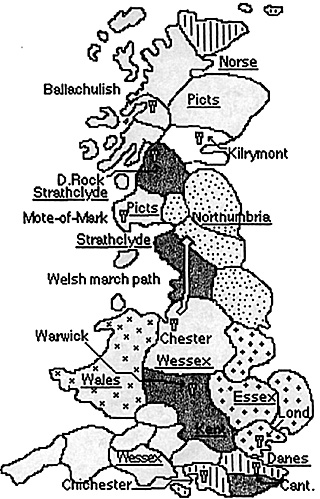
While Autumn's wet winds turned into Winter's icy gusts, a new menace to the island appeared on the eastern coast.
The Danes, scoffing at Britain's feeble Winter, grounded their longships' keels on North Kent's shore. They quickly laid siege to the fortified town of Canterbury, the province's capital. Caught unawares, the defenders soon surrendered. The Viking war chiefs then divided, half going north to besiege Londinium, the others sailing south to encircle Dover. As Winter wore on, it was clear that Canterbury's bloody fate had spurred these Saxons to hold out at least till Spring.
 While some animals slumber away the Winter, the sharp air seemed to
invigorate King Coenwulf of Mercia. He ignored news of the fall of the border
town of Wroexter to Wessex. Instead, the king recalled his armies bogged
down in Wales and East Anglia. Their eorls led them on lightning marches to
the capitals of two of the provinces Mercia had lost. The tables were turned
on the victorious men of Kent and Essex as they found themselves besieged
within the walls of Warwick and Northampton. When tidings from across Offa's Dyke spoke of open rebellion of one of Wales' subkings, they knew Mercia would receive no
distractions from that quarter. Stubbornly, they held out through Winter
as armies were marshaled to relieve them. With Dal Riata conquered,
King Circinn was proclaimed by his tribesmen as the greatest Pictish
warleader in centuries. The king smiled and turned his eyes southward
upon equally resurgent Strathclyde. They would be his next prey.
While some animals slumber away the Winter, the sharp air seemed to
invigorate King Coenwulf of Mercia. He ignored news of the fall of the border
town of Wroexter to Wessex. Instead, the king recalled his armies bogged
down in Wales and East Anglia. Their eorls led them on lightning marches to
the capitals of two of the provinces Mercia had lost. The tables were turned
on the victorious men of Kent and Essex as they found themselves besieged
within the walls of Warwick and Northampton. When tidings from across Offa's Dyke spoke of open rebellion of one of Wales' subkings, they knew Mercia would receive no
distractions from that quarter. Stubbornly, they held out through Winter
as armies were marshaled to relieve them. With Dal Riata conquered,
King Circinn was proclaimed by his tribesmen as the greatest Pictish
warleader in centuries. The king smiled and turned his eyes southward
upon equally resurgent Strathclyde. They would be his next prey.
At his command, the Picts swarmed across the border and laid siege to Dumbarton Rock. They seemed to ignore the cold as hardily as any Viking. Throughout the years, Dumbarton Rock had proved an ultimate refuge for the Britons. As King Ravenhawk gathered his legions to rescue his capital, the Picts marched another army into the province to block his route. Spring would doubtless see bloodshed as the struggle for the north entered a new phase.
Although there were no tabletop battles during the three Winter turns, the player's armies were surprisingly active. Campaign rules made marching or sailing large armies risky during Winter. Only four of the 10 kingdoms remained relatively dormant, though. Numerous sieges seemed to be the rule, instead, as 816 A.D. ended and 817 began.
As a side note, I'd promised the players when the campaign started that if they played their kingdom faithfully, but were conquered anyway, they could return as a "new" Viking invasion. Thus, the Dal Riatan player was transformed into the Danes, which arrived in force in these Winter turns.
More Bretwalda
Winter 815 A.D.
Spring 816 A.D.
Summer 816 A.D.
Fall 816 A.D.
Winter 816 A.D.
Spring 817 A.D.
Summer 817 A.D.
Autumn 817 A.D.
Winter 817-818 A.D.
March and April 818 A.D.
May and June 818 A.D.
Who Won? Part 1
Who Won? Part 2
Who Won? Part 3
Back to The Herald 25 Table of Contents
Back to The Herald List of Issues
Back to MagWeb Master Magazine List
© Copyright 1999 by HMGS-GL.
This article appears in MagWeb (Magazine Web) on the Internet World Wide Web. Other military history articles and gaming articles are available at http://www.magweb.com